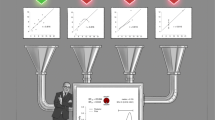Abstract
In searching for an appropriate utility function in the expected utility framework, we formulate four properties that we want the utility function to satisfy. We conduct a search for such a function, and we identify Pareto utility as a function satisfying all four desired properties. Pareto utility is a flexible yet simple and parsimonious two-parameter family. It exhibits decreasing absolute risk aversion and increasing but bounded relative risk aversion. It is applicable irrespective of the probability distribution relevant to the prospect to be evaluated. Pareto utility is therefore particularly suited for catastrophic risk analysis. A new and related class of generalized exponential (gexpo) utility functions is also studied. This class is particularly relevant in situations where absolute risk tolerance is thought to be concave rather than linear.
Article PDF
Similar content being viewed by others
Avoid common mistakes on your manuscript.
References
Abdellaoui M., Barrios C., Wakker P. P. (2007) Reconciling introspective utility with revealed preference: Experimental arguments based on prospect theory. Journal of Econometrics 138: 356–378
Abramowitz, M., Stegun, I. A. (eds) (1964) Handbook of mathematical functions with formulas, graphs, and mathematical tables. Dover, New York
Arrow K. J. (1971) Essays in the theory of risk bearing. North-Holland, Amsterdam
Barro R. J. (2006) Rare disasters and asset markets in the twentieth century. Quarterly Journal of Economics 121: 823–866
Barro R. J. (2009) Rare disasters, asset prices, and welfare costs. American Economic Review 99: 243–264
Binswanger H. P. (1980) Attitude toward risk: Experimental measurement in rural India. American Journal of Agricultural Economics 62: 395–407
Box G. E. C., Tiao G. C. (1973) Bayesian inference in statistical analysis. Addison-Wesley, Boston
Burr I. W. (1942) Cumulative frequency functions. Annals of Mathematical Statistics 13: 215–232
Burr I. W., Cislak P. J. (1968) On a general system of distributions: I. Its curve-shape characteristics. II The sample median. Journal of the American Statistical Association 63: 627–635
Castagnoli E., LiCalzi M. (1996) Expected utility without utility. Theory and Decision 41: 281–301
Chiappori, P.-A., & Paiella, M. (2008). Relative risk aversion is constant: Evidence from panel data. Discussion paper no. 5/2008. Department of Economic Studies, University of Naples ‘Parthenope’, Naples.
Denuit M., Eeckhoudt L. (2010) Stronger measures of higher-order risk attitudes. Journal of Economic Theory 145: 2027–2036
de Finetti B. (1952) Sulla preferibilità. Giornale degli Economisti e Annali di Economia 11: 685–709
Eeckhoudt L., Gollier C. (1995) Risk: Evaluation, management and sharing. Harvester Wheatsheaf, Hertfordshire
Friend I., Blume M. E. (1975) The demand for risky assets. American Economic Review 65: 900–922
Gerber H. U. (1979) An introduction to mathematical risk theory. S.S. Huebner Foundation Monograph. Irwin, Homewood, IL
Gollier C. (2001) The economics of risk and time. MIT Press, Cambridge, MA
Guiso L., Paiella M. (2008) Risk aversion, wealth, and background risk. Journal of the European Economic Association 6: 1109–1150
Harrison G. W., List J. A., Towe C. (2007) Naturally occurring preferences and exogenous laboratory experiments: A case study of risk aversion. Econometrica 75: 433–458
Holt C. A., Laury S. K. (2002) Risk aversion and incentive effects. American Economic Review 92: 1644–1655
Ikefuji, M., Laeven, R. J. A., Magnus, J. R., & Muris, C. (2011). Weitzman meets Nordhaus: Expected utility and catastrophic risk in a stochastic economy-climate model. Working paper, Tilburg University.
Johnson N. L., Kotz S., Balakrishnan N. (1995) Continuous univariate distributions (2nd ed.,Vol. 2). Wiley, New York
Köbberling V., Wakker P. P. (2005) An index of loss aversion. Journal of Economic Theory 122: 119–131
Mehra R., Prescott E. C. (1985) The equity premium: A puzzle. Journal of Monetary Economics 15: 145–161
Merton R. C. (1971) Optimum consumption and portfolio rules in a continuous-time model. Journal of Economic Theory 3: 373–413
Mossin J. (1968) Optimal multiperiod portfolio policies. Journal of Business 41: 215–229
Post T., van den Assem M. J., Baltussen G., Thaler R. H. (2008) Deal or no deal? Decision making under risk in a large-payoff game show. American Economic Review 98: 38–71
Pratt J. W. (1964) Risk aversion in the small and in the large. Econometrica 32: 122–136
Rabin M. (2000) Risk aversion and expected-utility theory: A calibration theorem. Econometrica 68: 1281–1292
Saha A. (1993) Expo-power utility: A flexible form for absolute and relative risk aversion. American Journal of Agricultural Economics 75: 905–913
Saha A., Shumway C. R., Talpaz H. (1994) Joint estimation of risk preference structure and technology using expo-power utility. American Journal of Agricultural Economics 76: 173–184
Saha A. (1997) Risk preference estimation in the nonlinear mean standard deviation approach. Economic Inquiry 35: 770–782
Stacy E. W. (1962) A generalization of the gamma distribution. Annals of Mathematical Statistics 33: 1187–1192
Subbotin M. Th. (1923) On the law of frequency of error. Mathematicheskii Sbornik 31: 296–301
Wakker P. P. (2008) Explaining the characteristics of the power (CRRA) utility family. Health Economics 17: 1329–1344
Yaari M. (1969) Some remarks on measures of risk aversion and their uses. Journal of Economic Theory 1: 315–329
Acknowledgments
We are grateful to Sjak Smulders and Peter Wakker for helpful discussions, and to the referee for constructive comments. This research was funded in part by the JSPS under grant C-22530177 (Ikefuji) and by the NWO under grant Vidi-2009 (Laeven). An earlier version of this article was circulated under the title ‘Burr utility’.
Open Access
This article is distributed under the terms of the Creative Commons Attribution License which permits any use, distribution, and reproduction in any medium, provided the original author(s) and the source are credited.
Author information
Authors and Affiliations
Corresponding author
Rights and permissions
Open Access This is an open access article distributed under the terms of the Creative Commons Attribution Noncommercial License (https://creativecommons.org/licenses/by-nc/2.0), which permits any noncommercial use, distribution, and reproduction in any medium, provided the original author(s) and source are credited.
About this article
Cite this article
Ikefuji, M., Laeven, R.J.A., Magnus, J.R. et al. Pareto utility. Theory Decis 75, 43–57 (2013). https://doi.org/10.1007/s11238-012-9293-8
Received:
Accepted:
Published:
Issue Date:
DOI: https://doi.org/10.1007/s11238-012-9293-8




